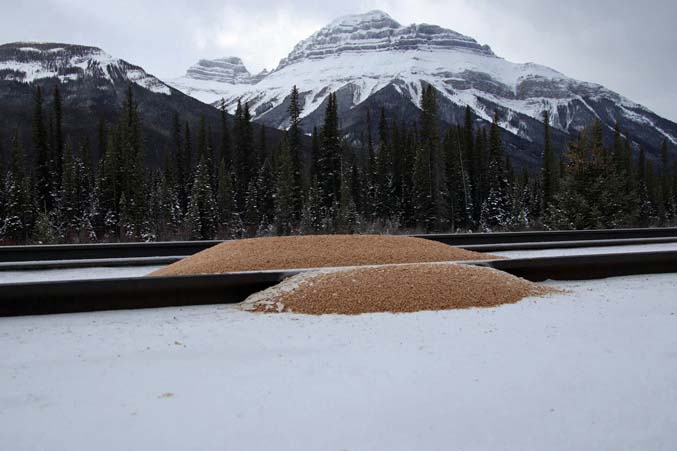
on Railway
Banff Alberta - Parks Canada has responded to three significant grain spills along the train tracks in Banff National Park in as many
months.
The latest spill, which occurred 17 Dec 2018 at a siding on the Canadian Pacific Railway (CP) near Hillsdale west of Banff, attracted deer but no
bears.
The railway company brought in the vacuum truck to clean the site within an hour of being contacted by Parks.
Parks Canada officials say the Bow Valley's biggest male grizzly bears, Bear No. 122, known as The Boss, and No. 136, dubbed Split Lip for his disfigured
mouth, were attracted to grain spills in October and November.
Bill Hunt, resource conservation manager for Banff National Park, said the latest spill was a "very large amount of grain."
"It may have been that CP was able to clean it up quickly, so bears didn't locate it, or maybe they'd denned by that time," he said.
"It's a concern any time we get that kind of grain spillage. Typically, more often what we see is a small trickle."
A spill near Hillsdale on 4 Nov 2018 attracted both The Boss and Split Lip.
At the end of October, Parks Canada's wildlife experts had to haze The Boss off the tracks near the Banff townsite where he was feasting on grain.
Bear 122 already survived a train strike in 2010 near Vermilion Lakes.
Since 2000, 17 other grizzly bears haven't been so lucky, which is a significant blow to Banff's population of about 60 grizzlies.
In fact, train strikes are the leading cause of death of the threatened species in this area.
They're threatened in Alberta because of their low reproductive rates, low population sizes, and long intervals between breeding and high rates of human caused
mortality.
A $1 million, five-year, Parks Canada-Canadian Pacific Railway joint study from 2012-2017 looked at ways to reduce the alarming number of bear deaths on the
train tracks, and in particular grizzly bear mortality.
Researchers found several factors are responsible for attracting bears to the railway, such as blind curves on the line that muffle approaching trains or high
protein foods such as elk and deer carcasses.
But it also confirmed grain is attracting bears, too.
Researchers found approximately 110 tonnes of grain are being deposited in the park, enough to feed about 50 bears for an entire year.
A spokesperson for CP said the company is investing more than half-billion on new grain hopper cars.
Over the next four years, CP plans to order approximately 5,900 hopper cars in total, enabling a complete removal of all low-capacity hoppers, including all
government of Canada cars, from the fleet.
"CP has a strong relationship with Parks Canada," said CP spokesperson Salem Woodrow in an email.
"It's CP's normal response to deploy the vacuum truck as soon as possible should a grain spill occur."
CP reported both of the earlier grain spills promptly to Parks Canada.
However, Hunt said a member of the public reported the 17 Dec 2018 grain spill.
"Unfortunately, it wasn't reported by the railway. That was a bit surprising," he said.
"We contacted CP and they were very prompt in cleaning it up. Within an hour they had the vacuum truck and able to clean it up."
Cathy Ellis.
provisions in Section 29 of the Canadian
Copyright Modernization Act.


